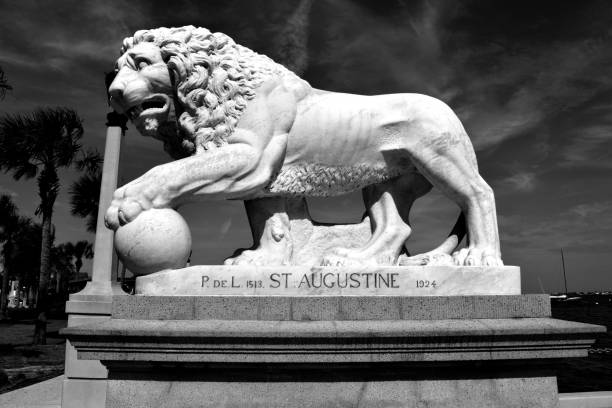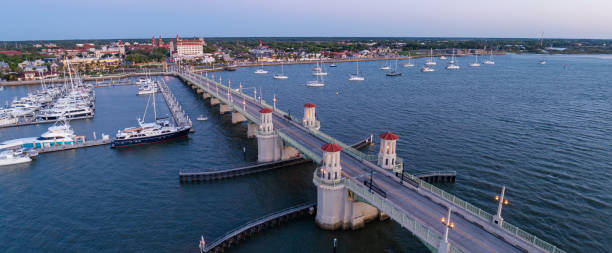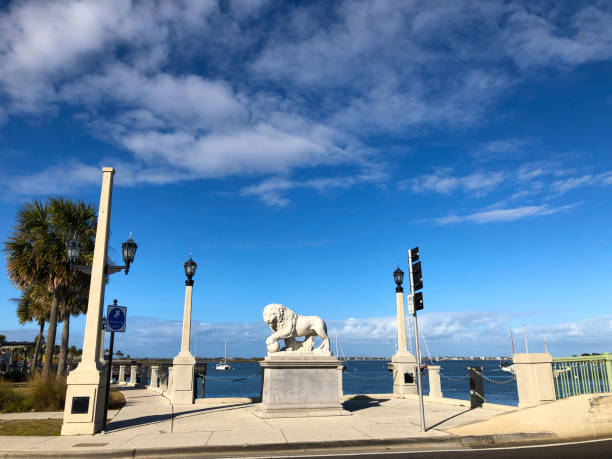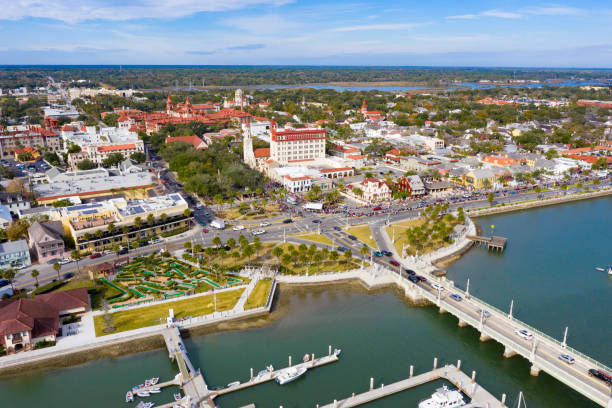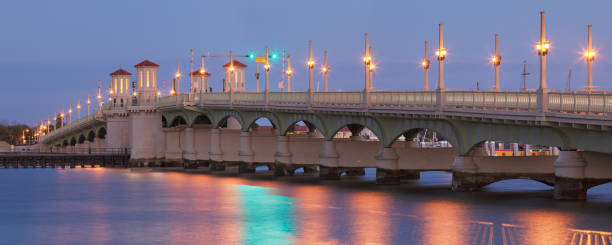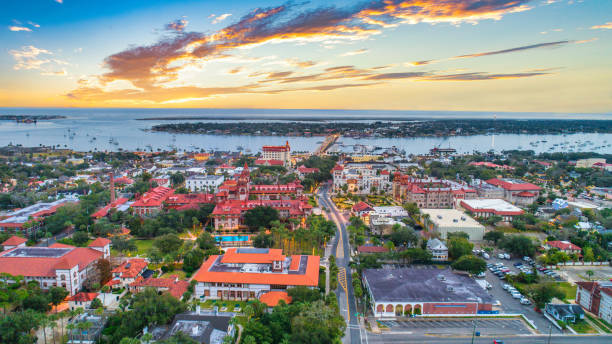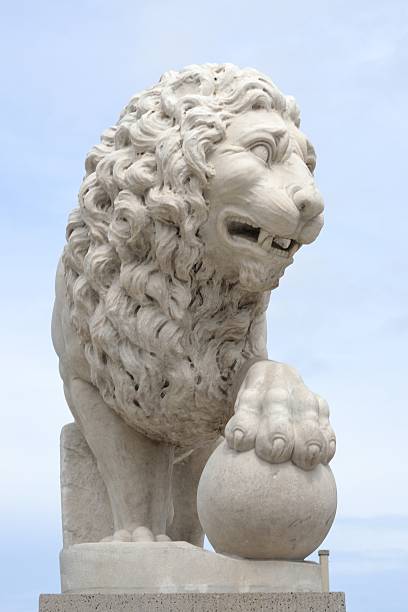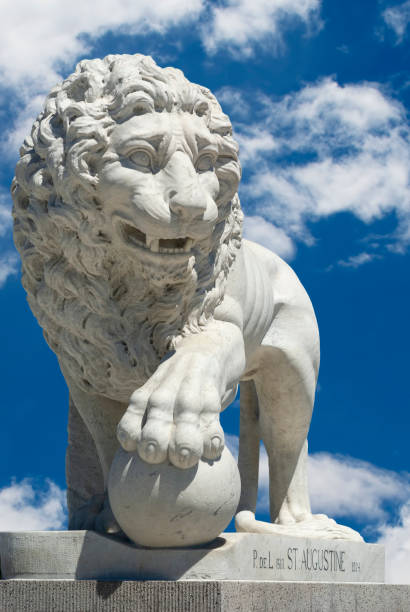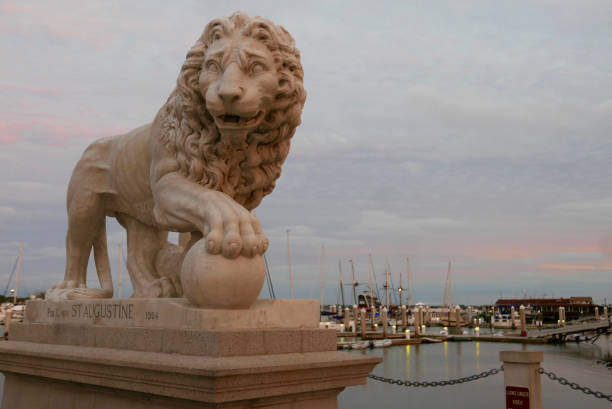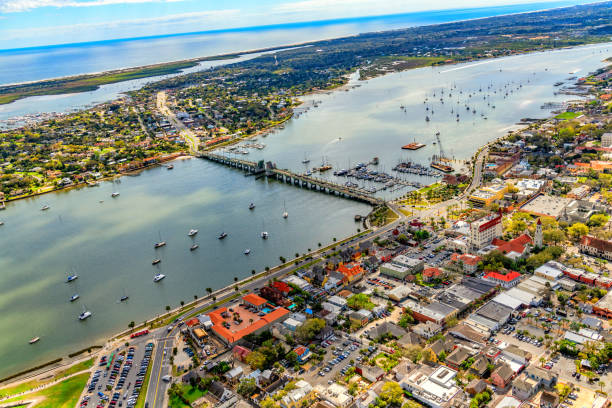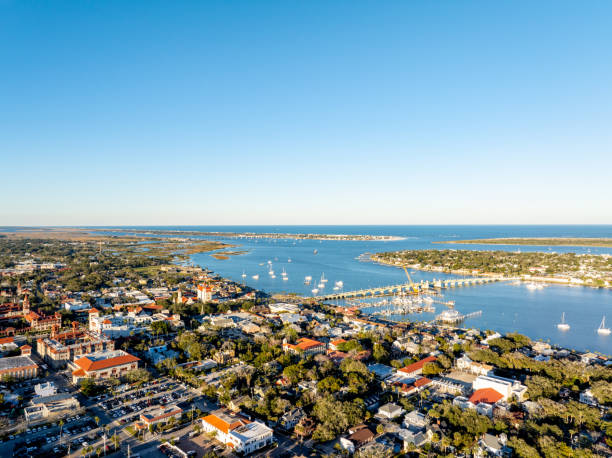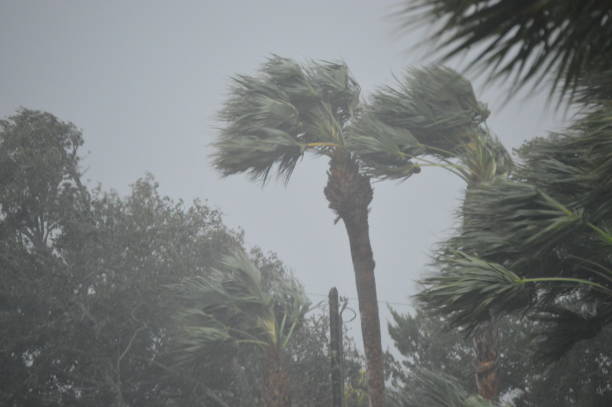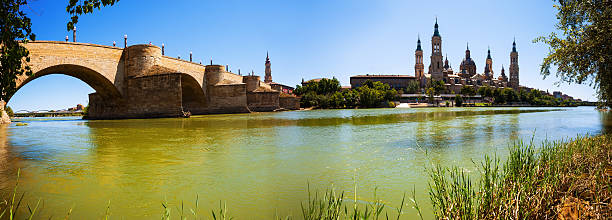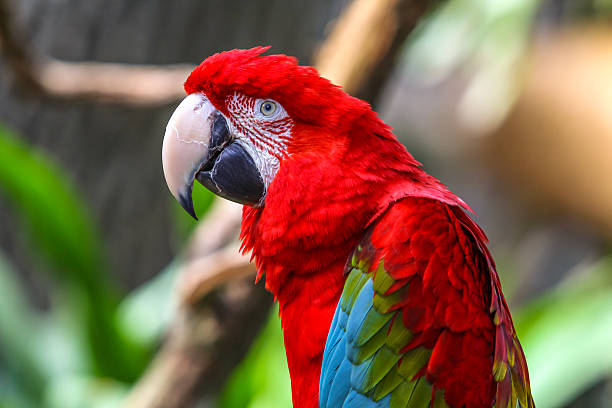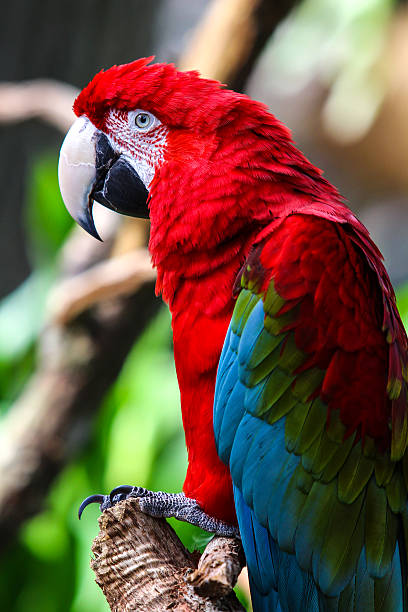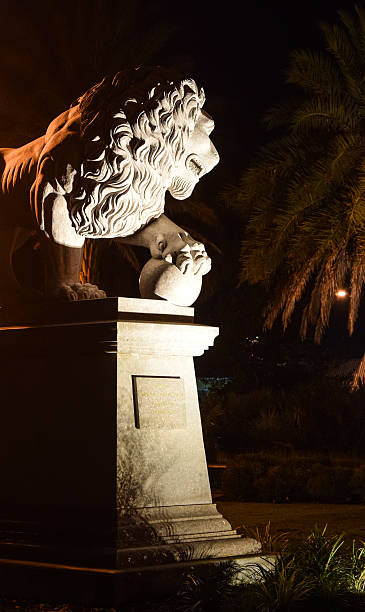
Bridge Of Lions Pictures, Images and Stock Photos
Browse 230+ bridge of lions stock photos and images available, or search for st augustine to find more great stock photos and pictures.

St. Augustine, Florida, USA city skyline and Bridge of Lions.
St. Augustine, Florida, USA city skyline and Bridge of Lions.
The Bridge of Lions in St. Augustine, Florida was opened in 1927. The lions are copies of the Medici Lions dating back to the 16th century in Italy.
St. Augustine, Florida, USA Skyline at Bridge of Lions.
Historic lion sculpture at Bridge Of Lions St. Augustine, Florida
St. Augustine, Florida, USA coastal skyline at sunset.
St. Augustine, Florida, USA Skyline at Bridge of Lions.
The Bridge of Lions over the Intracoastal Waterway in St. Augustine, Florida, USA on a sunny day.
The Bridge of Lions over the Matanza River and the distant view of the skyline of Saint Augustine, Florida, on the morning. Extra-large, high-resolution stitched panorama.
The Bridge of Lions over the Matanza River and the distant view of the skyline of Saint Augustine, Florida, on the morning. Extra-large, high-resolution stitched panorama.
Drone shot of the Bridge of Lions crossing the Matanzas River, which forms the Intracoastal Waterway in St. Augustine, Florida, on a sunny spring day.
St. Augustine, Florida, USA 02/22/2011: Sunny scenic view of Matanzas River in the late afternoon. The Bridge of Lions can be seen opening for a passing boat.
Pedestrians and drivers waiting on the famous Bridge of Lions, a drawbridge in the Florida city of St. Augustine so named after the lion figurines present.
The famous Bridge of Lions, a drawbridge in the Florida city of St. Augustine so named after the lion figurines present.
Sailboat and the Bridge of Lions in St Augustine, Florida USA
Aerial view of the Bridge of Lions crossing the Matanzas River in beautiful city of St. Augustine, Florida.
The Bridge of Lions (c. 1927) in St. Augustine, Florida - known as "The Most Beautiful Bridge in Dixie” - is a drawbridge spanning the Matanzas River between downtown St. Augustine and Anastasia Island. Listed on the National Register of Historic Places, It has been a symbol of the nation's oldest city.
St. Augustine, Florida, USA city skyline and Bridge of Lions.
A Medici lion guards the Bridge of Lions, with the Matanzas River in the background at St Augustine, Florida, the oldest city in the USA
Drone angle view of St. Augustine Florida.
The Bridge of Lions (c. 1927) in St. Augustine, Florida - known as "The Most Beautiful Bridge in Dixie” - is a drawbridge spanning the Matanzas River between downtown St. Augustine and Anastasia Island. Listed on the National Register of Historic Places, It has been a symbol of the nation's oldest city.
One of the lions at the Bridge of Lions in St Augustine, Florida.
St Augustine, Florida, USA Downtown Drone Skyline Aerial.
Aerial view of the beautiful city of St. Augustine, Florida.
The famous Bridge of Lions, a drawbridge in the Florida city of St. Augustine so named after the lion figurines guarding the bridge. This architectural feature of the bridge is considered public art.
The Bridge of Lions (c. 1927) in St. Augustine, Florida - known as "The Most Beautiful Bridge in Dixie” - is a drawbridge spanning the Matanzas River between downtown St. Augustine and Anastasia Island. Listed on the National Register of Historic Places, It has been a symbol of the nation's oldest city.
The Bridge of Lions was built in 1924 and the lion statues are copies of the Medici Lions which were made in 1598.
The Bridge of Lions in St. Augustine, Florida was opened in 1927.
Statue at the Entrance to the Bridge of Lions, St. Augustine, Florida.
The Bridge of Lions spanning the Matanzas River in St. Augustine, Florida shot from an altitude of about 1000 feet over the city.
A Medici lion guards the Bridge of Lions, with the Matanzas River in the background at St Augustine, Florida, the oldest city in the USA
Close view of lion statue at the bridge of lions, St. Augustine, Florida, blue sky with clouds in background, statue front view from slightly below, no people, sunny day
The beautiful city of St. Augustine, Florida along the Atlantic coastline shot from overhead.
A Medici lion guards the Bridge of Lions, with the Matanzas River in the background at St Augustine, Florida, the oldest city in the USA
Sculpture of lion. Bridge of Lions. St. Augustine, FL, USA.
One of four lions located near the Bridge of Lions, St. Augustine, FL
Close up of a lion sculpture at the end of the historic Bridge of Lions in Old Town St. Augustine, Florida, USA, at sunset
The beautiful city of St. Augustine, Florida along the Atlantic coastline shot from overhead.
One of the lions at the old Bridge of Lions in St Augustine, Florida. The bridge of Lions was finished in 1927 and a pair of copies of the 16th century Medici lions guard the bridge. The lions also commemorate the arrival of Ponce de Leon to Florida in 1513.
Hurricane Ian in Saint Augustine Florida at Castillo de san Marco national monument
The Bridge of Lions in St Augustine, Florida.
Blue sky, sunny day, wide shot, background sky, horizon and bridge of lions, city to the right, foreground, fort
Aerial image of the Bridge of Lions in St Augustine FL
Drone angle view of St. Augustine Florida.
Panorama of Zaragoza. Stone bridge and Cathedral. Aragon
Of the many different Psittacidae (true parrots) genera, six are classified as macaws: Ara, Anodorhynchus, Cyanopsitta, Primolius, Orthopsittaca, and Diopsittaca. Previously, the members of the genus Primolius were placed in Propyrrhura, but the former is correct in accordance with ICZN rules. Macaws are native to Central America and North America (only Mexico), South America, and formerly the Caribbean. Most species are associated with forests, especially rainforests, but others prefer woodland or savannah-like habitats. Proportionately larger beaks, long tails, and relatively bare, light-coloured, medial (facial patch) areas distinguish macaws from other parrots. Sometimes the facial patch is smaller in some species, and limited to a yellow patch around the eyes and a second patch near the base of the beak in the members of the genus Anodorhynchus. A macaw's facial feather pattern is as unique as a fingerprint. The largest macaws are the hyacinth, Buffon's (great green) and green-winged macaws. While still relatively large, macaws of the genera Cyanopsitta, Orthopsittaca and Primolius are significantly smaller than the members of Anodorhynchus and Ara. The smallest member of the family, the red-shouldered macaw, is no larger than some parakeets of the genus Aratinga. Macaws, like other parrots, toucans and woodpeckers, are zygodactyl, having their first and fourth toes pointing backward. There are 19 species of macaws, including extinct and critically endangered species. Ara chloropterus.
Of the many different Psittacidae (true parrots) genera, six are classified as macaws: Ara, Anodorhynchus, Cyanopsitta, Primolius, Orthopsittaca, and Diopsittaca. Previously, the members of the genus Primolius were placed in Propyrrhura, but the former is correct in accordance with ICZN rules. Macaws are native to Central America and North America (only Mexico), South America, and formerly the Caribbean. Most species are associated with forests, especially rainforests, but others prefer woodland or savannah-like habitats. Proportionately larger beaks, long tails, and relatively bare, light-coloured, medial (facial patch) areas distinguish macaws from other parrots. Sometimes the facial patch is smaller in some species, and limited to a yellow patch around the eyes and a second patch near the base of the beak in the members of the genus Anodorhynchus. A macaw's facial feather pattern is as unique as a fingerprint. The largest macaws are the hyacinth, Buffon's (great green) and green-winged macaws. While still relatively large, macaws of the genera Cyanopsitta, Orthopsittaca and Primolius are significantly smaller than the members of Anodorhynchus and Ara. The smallest member of the family, the red-shouldered macaw, is no larger than some parakeets of the genus Aratinga. Macaws, like other parrots, toucans and woodpeckers, are zygodactyl, having their first and fourth toes pointing backward. There are 19 species of macaws, including extinct and critically endangered species. Ara chloropterus.
Aerial view of the beautiful city of St. Augustine, Florida.
Pedestrians and drivers on the famous Bridge of Lions, a drawbridge in the Florida city of St. Augustine so named after the lion figurines present.
Lion statue guards the Bridge of Lions at night in St. Augustine, Florida
The walkway of the Matanzas River at Night with Bidge of Lions on St. Augustine, Florida.
The Bridge of Lions over the Intracoastal Waterway in St. Augustine, Florida, USA on a sunny day.
Lion monument at night guards the Bridge of Lions in St. Augustine, Florida.
Hurricane Ian in Saint Augustine Florida at Castillo de san Marco national monument
Hurricane Ian in Saint Augustine Florida at Castillo de san Marco national monument
Hurricane Ian in Saint Augustine Florida at Castillo de san Marco national monument



